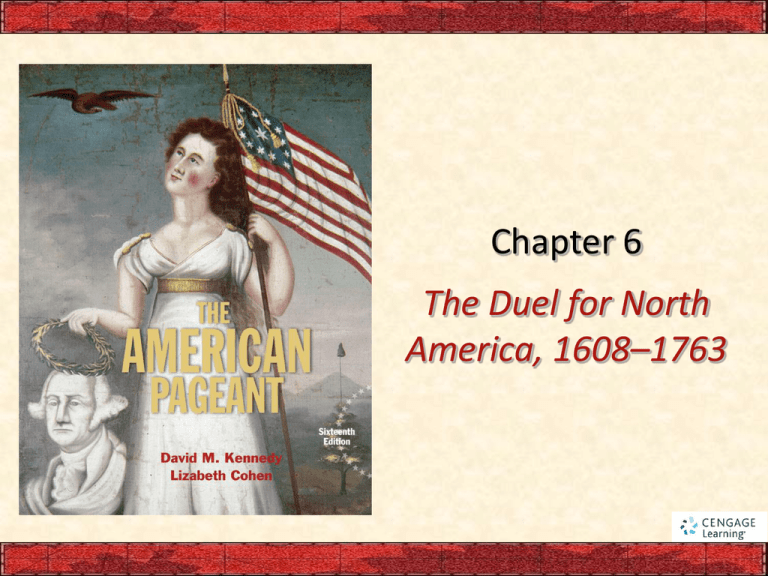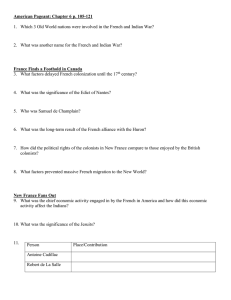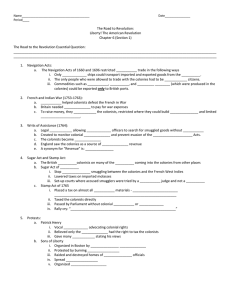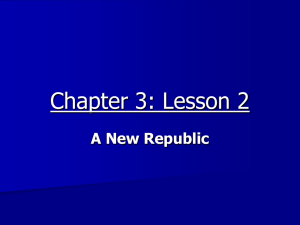Chapter 6 The Duel for North America, 1608–1763
advertisement

Chapter 6 The Duel for North America, 1608–1763 I. France Finds a Foothold in Canada • France was a latecomer in the scramble for New World real estate: – It was convulsed by foreign wars and domestic strife during the 1500s. – It was involved in clashes between Roman Catholics and Protestant Huguenots. – On St. Bartholomew’s Day, 1572, over 10,000 Huguenots―men, women, and children―were butchered in cold blood. I. France Finds a Foothold in Canada (cont.) • 1598: Era of the Edict of Nantes: – Issued by the crown, it granted limited toleration to French Protestants. – France blossomed, led by brilliant ministers and by King Louis XIV, who reigned for 72 years (1643– 1715). – Fatefully for North America, he took a deep interest in overseas colonies. I. France Finds a Foothold in Canada (cont.) • 1608: The permanent beginnings of a French empire (see Map. 6.1) were established at Québec: – Efforts were led by Samuel de Champlain, “Father of New France.” – He established friendly relationships with Huron Indian tribes. – He entered into a treaty with the Huron against the Iroquois tribes of the upper New York area. Map 6.1 p102 I. France Finds a Foothold in Canada (cont.) • Government of New France (Canada) finally fell under direct control of the king. – This regime was almost completely autocratic. – The people elected no representative assemblies. – They did not enjoy the right to trial by jury, as in the English colonies. I. France Finds a Foothold in Canada (cont.) • The population of Catholic New France grew slowly: – In the late 1750s, only 60,000 or so whites were in New France. – Landowning French peasants had little motive to move. – French Huguenots were denied a refuge. – The French government favored its Caribbean islands. II. New France Fans Out • New France contained one valuable resource—the beaver: – European fashion-setters valued beaver-pelt hats. – Colorful coureurs de bois trapped beavers. – They littered the land with scores of place names: Baton Rouge (red stick), Terre Haute (high land), Des Moines (some monks). II. New France Fans Out (cont.) • French voyageurs recruited Indians into the fur business (see Map 6.2): – The Indian fur flotilla that arrived in Montréal in 1693 numbered 400 canoes. – Many of these Indians were decimated by the white man’s diseases and alcohol. – Mass slaughter of beavers violated many Indians’ religious beliefs and caused ecological damage. p102 Map 6.2 p103 II. New France Fans Out (cont.) • Catholic missionaries (Jesuits) tried to save Indians for Christ and from fur-trappers: – Some suffered torture by Indians. – They had few converts but did play a vital role as explorers and geographers. – Other explorers sought neither souls nor fur, but empire to block English and Spanish expansion. II. New France Fans Out (cont.) • French explorers: – Antoine Cadillac founded Detroit, “the City of Straits.” – Robert de La Salle floated down the Mississippi in 1682 to where it mingles with the Gulf. – He named the interior basin “Louisiana,” after Louis XIV. – He failed to find the Mississippi delta, landed in Spanish Texas, and in 1687 was murdered. II. New France Fans Out (cont.) • The French planted several fortified posts in what is now Mississippi and Louisiana: – New Orleans was founded in 1718. – The forts in fertile Illinois country (Kaskaskia, Cahokia, and Vincennes) became the grain garden of France’s North America empire. III. The Clash of Empires • The earliest contests among European powers for control of North America: – In King William’s War (1689–1697) and Queen Anne’s War (1702–1713) (see Table 6.1), British colonists fought French coureurs de bois. – Indian allies ravaged Schenectady, New York, and Deerfield, Massachusetts (see Map 6.3). Map 6.3 p104 Table 6.1 p104 III. The Clash of Empires (cont.) • Peace terms, signed at Utrecht in 1713, revealed how badly France and its Spanish ally had been beaten (see Map. 6.4): – Britain gained French-populated Acadia (which the British renamed Nova Scotia) as well as Newfoundland and Hudson Bay. – Losses pinched France’s settlements on the St. Lawrence and thereby sealed their ultimate doom. p105 Map 6.4 p105 III. The Clash of Empires (cont.) • American colonies then experienced decades of “salutary neglect”—fertile soil for roots of independence. • British also won limited trading rights in Spanish America, which led to smuggling. • British captain Robert Jenkins had one ear sliced off by a Spanish official, which led to the War of Jenkins’s Ear in 1739. III. The Clash of Empires (cont.) • The War of Jenkins’s Ear merged with larger War of Austrian Succession in Europe (see Table 6.2), called King George’s War in America: – New Englanders with help from British navy captured Louisbourg, which commanded the St. Lawrence River (see Map 6.3). – But was returned to France by the treaty of 1748. – France still clung to its vast holdings. IV. George Washington Inaugurates War with France • The Ohio Valley became the chief bone of contention between the French and British: – For the British, it was a critical area for westward movement. – The French needed it to link their Canadian holdings to those of the lower Mississippi Valley. – The British colonists were determined to fight for their economic security and supremacy. Table 6.2 p106 p106 IV. George Washington Inaugurates War with France (cont.) • Ohio Valley rivalry increased tensions: – The French erected a chain of forts along the Ohio River. – Fort Duquesne was at the pivotal point where the Monongahela and Allegheny Rivers join to form the Ohio River—the later site of Pittsburgh. – In 1754, the governor of Virginia sent young George Washington to Ohio Country to secure the Virginians’ claim. IV. George Washington Inaugurates War with France (cont.) • In this skirmish: – Washington met some French troops about 40 miles from Fort Duquesne (Map 6.5) and fired. – French leader was killed and his men retreated. – French returned and surrounded Washington. – Washington, after 10-hour siege, surrendered but was allowed to march troops away with honor. – In response, the British brutally uprooted French Acadians and scattered them as far as Louisiana: descendants are “Cajuns.” Map 6.5 p107 V. Global War and Colonial Disunity • First 3 Anglo-French colonial wars started in Europe, but the 4th one started in America: • The French and Indian War, started by Washington in the Ohio Valley (1754), widened after two years into the Seven Years’ War in America, Europe, the West Indies, Africa, Philippines, and on the ocean. • The Seven Years’ War was a 7-sea war (see Map 6.6). Map 6.6 p108 V. Global War and Colonial Disunity (cont.) • The crisis demanded concerted action: – In 1754, the British government summoned an intercolonial congress to met at Albany, N.Y. – Only 7 colonies sent delegates. – The immediate purpose was to control Iroquois tribes loyal to Britain. – The longer-range goal was to increase colonial unity and thus bolster common defense against France. V. Global War and Colonial Disunity (cont.) • Benjamin Franklin was the leading spirit at the Albany Congress: – He published the famous cartoon “Join, or Die.” – He presented a well-devised but premature scheme for colonial home rule. – Albany delegates unanimously adopted it. – Individual colonies rejected it, as did the British government. p109 V. Global War and Colonial Disunity (cont.) • Franklin’s scheme (cont.): – To colonists, it did not give enough independence. – To the British, it gave too much. – Franklin observed that everyone agreed on need for union, but were “distracted” when they tried to agree on details. VI. Braddock’s Blundering and Its Aftermath • Opening clashes of war went badly for British: – General Edward Braddock was sent to Virginia with a strong detachment of British regulars. – He set out in 1755 with 2,000 men to capture Fort Duquesne. – On his way he met a smaller French and Indian army. VI. Braddock’s Blundering and Its Aftermath (cont.) • Opening clashes (cont.): – Washington had two horses shot from under him and four bullets pierced his coat. – Braddock was fatally wounded. – The British were routed and suffered large losses. – Inflamed by easy victory, Indians launched assaults from Pennsylvania to North Carolina. – Washington with 300 men tried to defend frontier. – The British experienced defeat after defeat. VII. Pitt’s Palms of Victory • William Pitt was Britain's superlative leader: – He was known as the “Great Commoner.” – 1757: He became a key leader in the London government. – He downplayed assaults on the French West Indies. – He concentrated on the vital Québec-Montréal area of Canada. – He picked young and energetic military leaders. VII. Pitt’s Palms of Victory (cont.) • William Pitt (cont.): – 1758: He dispatched an expedition that took Louisbourg, the first major British victory. – He sent James Wolfe to take Québec. – Wolfe battled the Marquis de Montcalm’s forces on the Plains of Abraham outside of Québec. – Both commanders were fatally wounded. – The French were defeated and Québec surrendered. p110 VII. Pitt’s Palms of Victory (cont.) • Battle of Québec (1759) was one of the most significant battles in British and American history: – When Montreal fell in 1760, the French flag fluttered for the last time in Canada. – The Treaty of Paris in 1763 displaced the French empire from the North American continent. – The French were able to maintain several small but valuable sugar islands in the West Indies. VII. Pitt’s Palms of Victory (cont.) • France also received two never-to-be-fortified islets in Gulf of St. Lawrence for fishing stations. • Final blow: France ceded to Spain all of transMississippi Louisiana, including New Orleans (see Map 6.7). • Great Britain emerged as: – The dominant power in North America – The leading world naval power Map 6.7a p111 Map 6.7b p111 VIII. Restless Colonists • Britain’s colonists emerged with increased confidence in their military strength and skill. – 20,000 colonists were under arms at war’s end. – War shattered the myth of British invincibility. – Displaying the contempt of professional soldiers, the British refused to recognize any American militia commission above the rank of captain. p112 VIII. Restless Colonists (cont.) • British officials were distressed by reluctance of some colonies to support the war wholeheartedly. • Some colonies, self-centered and alienated by their distance from war, refused to provide troops and money for the conflict. • Colonies still exhibited strong tendencies toward disunity. VIII. Restless Colonists (cont.) • But unity among colonies received some encouragement during the war: – When soldiers and statesmen from different colonies met, they discovered they were all Americans who spoke the same language and shared common ideals. – A coherent nation could emerge, but it would not be easy. IX. War’s Fateful Aftermath • Removal of French menace in Canada profoundly affected American attitudes: – In a sense history of the United States began with the fall of Québec and Montréal. – Spanish and Indian threats were substantially reduced. – Spanish removal from Florida and French removal from Canada deprived Indians of potential allies to outset growing British power. IX. War’s Fateful Aftermath (cont.) • Pontiac’s uprising by Ottawa Chief Pontiac: – Laid siege to Detroit in 1763 and overran all but three British posts west of the Appalachians. – Killed some 2,000 soldiers and settlers. – British retaliated swiftly and cruelly with a primitive version of biological warfare. – Pontiac died in 1769 at hands of a rival chieftain. • Colonists were now free to cross Appalachian Mountains and take western lands. IX. War’s Fateful Aftermath (cont.) • But London issued the Proclamation of 1763, which banned settlement beyond the Appalachians (see Map 6.8). – Britain only wanted to avoid another bloody Indian uprising. • But angry colonists flouted the proclamation. • The stage was set for conflict: – The colonists refused to be restrained. – British government was frustrated with colonies. Map 6.8 p114 p115







